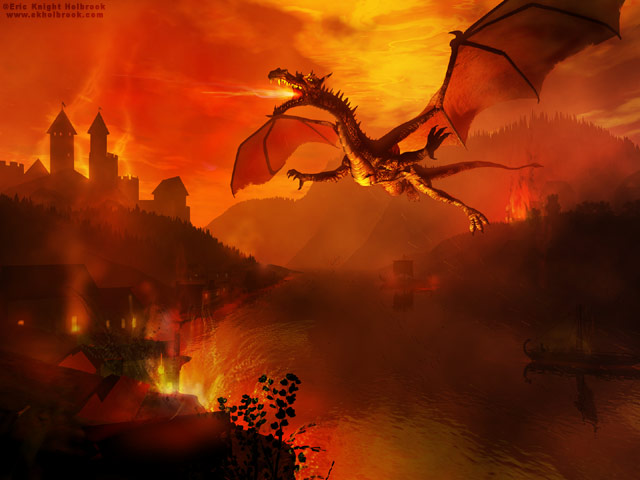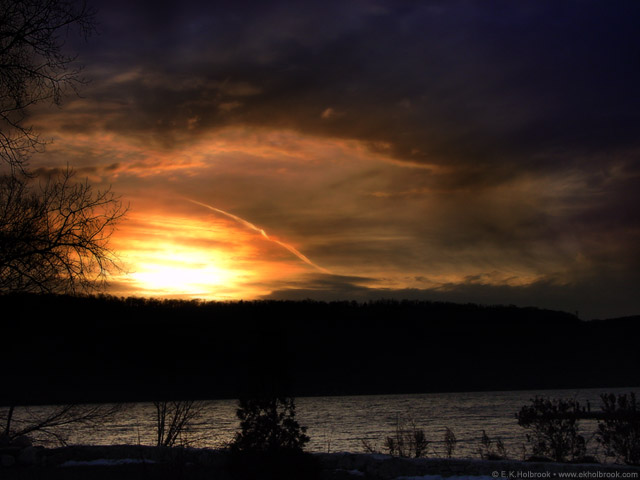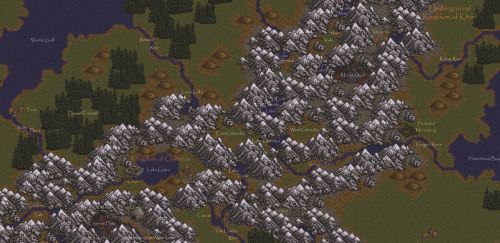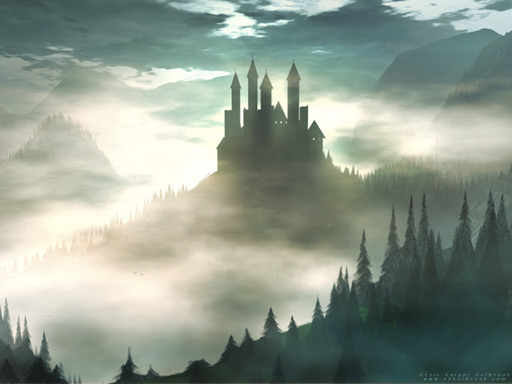Kingdom of Galencia
This most ancient of Human nations has stood in Rheuthengage Mountains around Lake Galen for over a millennium. Wealthy for the ores it mines, it sits as crossroads between humanity and northeast Tarien, maintaining excellent relations with both the Underground Kingdom of the Children of Kharl and the Soulmeliti Forests.
Structure
The Galencian political system is a hereditary monarchy. The King has absolute power, granted to him by people of the land over a thousand years ago. He makes all of the laws, and is the supreme commander of the military, which enforces them. In general, little crime is committed, and the mountainous terrain surrounding the Kingdom protects Galencia from invasion, so the military is small, consisting of an army and few ships on Lake Galen. The King has many advisors, chosen by him and allowed to serve at his discretion. He appoints the district judges, which number 15, and travel from town to town passing out sentence. A great judge, appointed by the King and serving at his discretion, resides in Geyla, where all crimes against the state are tried. The judge hears both sides of the story, listens to witnesses, decides guilt, and passes sentence. A Count, who is directly responsible to the King, governs each town. The position is hereditary, but the King reserves the right to remove the title from anyone and place any person in the position. Such a drastic action has not occurred for over three centuries.
Culture
Galencian culture society consists mostly of farmers and miners, although tradesman and artisans make up a substantial portion of the population in Geyla and Geran. The people are generally cordial to all races, and simple in their tastes and pleasures. Few instances of decadence exist, mostly in well to do merchants. Even the Galencian nobility lives simple, although often less strenuous, lives. Galencians value life greatly, and remember the difficult times in their past. Therefore, most Galencians will always offer a stranger a meal and a place to spend the night. Galencians value their friends and families greatly, and will set aside their own success to help a relative get back on their feet, or a townsman trapped in a mine. This sharing attitude has lead to great efficiency in their mining and farming, and as a result, the standard of living for the poorest Galencian is far higher than the depraved of other nations.
History
Galencian history begins in 945 BC, when human wanders made their way up His Lord’s River, and settled at the western end of a tremendous lake. The leader of these wanders, Andaran Galen, sacrificed his own rations to keep children fed, and died of malnutrition during the first winter. By a general vote, the settlers named the lake Galen after the great leader, and the settlement named Geyla, after his daughter, who died in childbirth. The settlement grew quickly, and by 902 BC, the first walls were erected around the city. Relations opened with the Soulmeliti in 880 BC when a band of Kirsh’shaluush wandered into the settlement, on a goblin hunt. The Soulmeliti stayed for twenty years, teaching the Galencians (as they now called themselves) modern ideas concerning politics, language, and economics. With the advent of understanding centralized political power, and a rapid growth of the population, which made small community meetings impossible, the Galencians selected Han Markudar as their first King in 866 BC.
Galencia continued to expand, and with its growing population, the steppes surrounding Lake Galen evolved in lush farmlands. Small settlements sprung up around the city, and towns begin to grow farther away from the city. By 704 BC, the towns of Geran, and Tehrith were large enough to require their own governing bodies. Each town elected Counts, to rule themselves and the surrounding farms. The King, Raliph Markudar IV, made these titles hereditary.
Galencians began to hone their engineering skills in 728 BC when the architect Wolfgang Havershod designed and began construction on a massive cathedral for Arimathica. Some sixty years later, this generational project completed with the construction of a small, private chapel and living quarters for the priests.
Galencians relations with the Soulmeliti Forests continued to remain cordial. By 650 BC many Galencians lived in New Solarin and may Soulmeliti made their homes in Geyla. The small town of Geran became a focal point in the ever-growing trade between the two nations, and expanded quickly. In 645 BC, the King Raliph Markudar VI decided to formalize relations with his distant neighbors. The King journeyed to the Drakshal Monastery where he met with Betriem Styvalhyme, the current Forestspeaker, and worked out a military and economic treaty. This treaty, known as the “Drakshal Accords,” is oldest living treaty on Tarien today.
Shortly thereafter, a Khadric trader brought mithril and mead to Geran, and trade between the two nations began immediately. The excellence of Khadric mead made it a high demand item, and the Galencians quickly ran up a great debt with the Underground Kingdom of Kharl. To pay off the debt, King Raliph Markudar VI had the village of Ghendra built and chartered the Royal Ghendran Mining Company. Khadric experts guided this, Galencia’s first venture into mining. The mine, deep into the earth and rich in gold, became a great source of revenue for the Kingdom. Similar mines sprung up around iron, silver, and gold deposits in the regions. The most successful of these mines, east of Geyla, unearthed tons of iron which, after its sale to the Khadra, was smelted into steel. The village of Ironstone, built around this mine, grew in economic power and remains an essential point in the ongoing Galencian-Khadric trade.
Tragedy struck in 543 BC when, for no apparent reason, the great dracolich Kerr descended upon the city of Geyla, destroying it with repeated blasts of fire and magic. The city, with no defenses against aerial assault, was reduced to rubble within minutes. Thousands died, and refugees filled the countryside, with over two thousand of them fleeing to the Drakshal Monastery. At the monastery, the Monks and surviving priests of Arimathica tended to the wounded. Due to their assistance with the refugees, the Arimathican Church became the primary faith in the religion. In an annual ceremony, the Arimathican Churches honors the Monks and Kingdom shuts down for the celebration of Drakshal Benevolence. Among reconstruction projects was a new design for the cathedral to Arimathica. In 540 BC, the Grand Master of the Drakshal Order, Dao, presides at groundbreaking ceremonies. The Temple's design, by Fredrick Bontoft, has twenty-one spires, the tallest reaching over 300 feet into the air. Reconstruction of the cathedral finished in 519 BC with the painting of “Arimatica’s Solace”, a painting on the chapel’s ceiling. Impressed by his people’s dedication to the reconstruction, King Sedric the Great created the Kingsday – a day of rest every tenday for those working to restore the city. By 517 BC, the city was rebuilt and life began to return to normal in the Empire. A great castle, Malta, with several aerial oriented ballista, was constructed across the River Prydith from Geyla.
The following century brought turmoil to the normally calm city. In 508 BC, King Sedric the Great died, without an heir, under what many scholars consider suspicious circumstances. Theodore I assumed the throne. Later, in 487 BC, Galencian soldiers are massacred while reinforcing the Soulmeliti against Ork skirmishes. While recorded in history as heroes, it becomes clear to Galencians that they have no place in the wars of the northeast.
In 377 BC, a scholar from Geran writes Singularity, a philosophical work that argues against the division of the body and soul seen in the Soulmeliti work, The Duality of Metaphysics, by Andra Moeynshiem. The book became extremely popular with the Khadric, who believed that the body is a physical manifestation of the soul. It becomes the first non-Khadric book printed on Khadric presses. Jan Crito’s investigations into metaphysics led him to some strange conclusions. He published these conclusions, regarding the mortal need to invent immortal gods, in his book, The Atheist, in 372 BC. The book, Tarien’s first novel, implied that the gods did not exist at all, and by the early weeks of 371 BC, Jan Crito had been excommunicated by nineteen separate churches in Galencia. He burned as a heretic by Anderi fundamentalists in early spring.
Life progressed quietly in Galencia until 75 AC, when Dunkirk, an entrepreneurial young man, smuggled the plans for the Khadric printing press into Geran. While this created a diplomatic incident, King Han Markudar X issues a formal apology, and pays the Khadric one million gold pieces, (in the form of 500 gold piece adamantine bars) in damages.
In 50 AC Galencian merchants expanded their trade to the south. They travel to Mennith, bringing mithril and gold. The Mennithite church, however, disapproves of associating with such heathens, especially heathens who freely live with demi-human devils. Bypassing Mennith completely, Galencian merchants build a house on what is today the Grennig Peninsula, in 54 AC. They begin to construct docks and ship, to trade with the strange land to the south, that the Mennithites had called Eldoria. A group of pilgrims from the Empire settled on this peninsula with the merchants, and city of Grennig begins to grow. By 75 AC negotiations between Galencian and Eldorian diplomats result in Grennig becoming a formal part of the Eldorian Empire, with Galencia retaining extra-territorial rights to Castle Grennig, on the outskirts of the city. By 83 AC, traders between the two nations travel south, through the mountains to Grennig, not Mennith, before boarding ships bound for the Island of Eldoria.
Another diplomatic incident, involving the Nerrid Secret Service, occurred in 92 AC. An agent, known only as agent gopher, was arrested for espionage when discovered behind the curtains in the Queen’s dressing room. During his trial, the N.S.S. disavows any knowledge of his existence, even to the point that Agent Mountain Goat stared at his brethren and stated “I see no Nerrid, except for myself, in this room.” Agent Gopher was put to death. A few days later, the master minter of the Galencian gold eagles noticed the word “gopher” imprinted on every coin. The error was corrected within a month.
The Count of Geran’s residence served as the meeting place for negations between Eldoria, Galencia, and Soulmeliti during the initial phases of construction for the Trans Rhuethengage Highway, in 243 AC. The highway’s completion in 288 AC marks one of the greatest events in engineering and ingenuity in the history of Tarien.
Galencia made good on the “Drakshal Accords” in 453 AC when they reinforced the Soulmeliti during the Great War. While Galencian soldiers fought hard, the citizens did not suffer from first hand ravages of war. Peace has covered the Kingdom since that time, and with trade prospering, the only loss to the Kingdom has been Castle Grennig, which became officially part of the Principality when it gained independence from Eldoria in 458 AC.
Like Zennon and Grennig, Galencia followed Eldoria’s lead by banning magic in 610 AC. Hundreds of magi and suspected magi were burned at the stake as the country purged itselfofthe arcane. This event marks the first time that Galencia truly shifted its policies toward Eldoria, and away for the Khadra and Soulmeliti. During the Cleansing, as it became known, a young mage burnt herself on the steps of Arimathica’s Cathedral. The fires from her body spread, magically, of course, to the Cathedral proper, razing it to the ground. With generous donations from the king, the cathedral was fully rebuilt by 632 AC.
Tragedy struck in 653 AC when a caravan between Geyla and Dalencroft is buried in a rockslide on the Trans-Rheuthengage Highway. Over ten miles of highway is rendered unusable King Markum IV of Geyla hires a Khadric engineer, Harkin Ironreaver, to rebuild the highway. After a short assessment, Harkan announces that rather than rerouting the Highway, he would design and build a tunnel that stretches for 5 miles beneath the mountains. With the highway rebuilt, and trad restored, live Galencia retuned to normal.
Demography and Population
Galencia is a kingdom at a crossroads – it is a human nation that was never ruled by Eldoria and a gateway to the mysterious and ancient cultures of northeastern Tarien. This unique position makes it far more cosmopolitan that most nations. Enclaves of Soulmeliti and Khadra are common in Geyla and Geran. The capital even includes small neighborhoods of Dharja, Flinds and Elynthi. While still rare, even the site of an Ork would not automatically send people running for the city guard. Combined the Great Temple of Arimathica’s policies to heal all who need it, regardless of race or creed, and Galencia is one of the most welcoming nations in Tarein.
Geographically, it is not quite on the shores of human hub that is the Eldorian Sea but not far enough from it to escape its influence. While most people here are proud of its long history and its open-mindedness, there are still those that harbor resentment to non-human races. This sentiment, more common in rural villages than around the shores of Lake Geran, often have little basis for their hate beyond the wild stories passed from parent to child or the rantings of the occasional Mennethite passerby.
Territories
Galencia sits in the midst of the Rhuethengage Mountains, the tallest and wildest range in all of Tarien. At the center of the Kingdom is Lake Galen, a great expanse of blue, mountain water over a forty leagues long and 15 miles wide. The lake, reaching depths of over a thousand feet, houses a variety of fish, and even a mythical monster named Gara. The valley surrounding the lake is fertile, and the home to many farms. The mighty river Prydith leaves the lake to the west. The hills and mountains surround the valley are ripe with ore, and many small villages and mining towns.
The weather here is temperate and dry, although a bit chilly in the fall and spring. Winter brings frost, and rarely snow. The majority of the rain falls in a cold and constant drizzle during the fall, and torrential downpours during the spring. Consequently, most farmers have dug reservoirs to irrigate their farmlands. Winds in the region are high, are kicking up to fifty miles an hour over the center of the lake.
Military
As a powerful kingdom, Galencia maintains a standing army. Legionnaires, however, they are not. In general, the kingdom relies on its natural, mountainous landscape to defend it from invaders. As a result, its army is small in size, generally made up of the down-trodden seeking a new lease on life. There is not a strong tradition of noble officers in the Kingdom, making most of them lifelong soldiers, promoted through the ranks. This has an interesting contrast to Eldoria, as unlike the Legion, where relentless training combined with political appointments make for strong, but sometimes incompetently lead units. Galencia’s army, instead, is full of savvy, veteran officers but constantly finds itself with new recruits. The lower funding level means less training, resulting in an army with less discipline and skill.
One area where Galencia shines, however, is in its military engineers. Charged with maintenance of the Highway, they are experts at building roads through steep mountain passes. With this knowledge comes the ability to destroy roads and bridges quickly and efficiently, if needed. Indeed, isolation is the chief strategy planned should another Great War arise. Others maintain the formidable air defenses of Geyla. While more of a tradition at this point – no dragon has been seen in the skies above Galencia for centuries – the tradition of air defense is a strong one and visitors to the capital often gawk at the mighty ballista lining its walls.
Religion
Most religions are acknowledged in Galencia. Arimathica, due to her great assistance in the past, has become dominant. The Arimathican church has its center in the great temple at Geyla; a tremendous structure built by Drakshal, Galencians, and Khadric immediately after Kerr destroyed the city. It is the oldest building in the Kingdom and new Kings are ordained here. Anderi’s church falls into a close second, and many Galencians pay tribute to Kharl, the Khadric god.
Foreign Relations
In policy and in practice, the Kingdom of Galencia strives to maintain positive relations with all other nations. As a crossroads, situated between the human lands of central Tarien and the ancient, non-human cultures of the northeast, it is adept at the art of diplomacy. The Kingdom maintains formal non-aggression treats with Eldoria and most of its former colonies, the exception of course, being Mennith who treats with no one. Similar pacts were signed centuries ago with the Underground Kingdom of the Children of Kharl and the Soulmeliti Forests. And while no formal arrangements have been made with Zennonaize Confederacy, Flietch-ta Empire, or Elanthai Council, one could call all of these relationships cordial.
The economic ties to the Khadra and Soulmeliti, built millennia ago and strengthened with the Trans-Rheuthengage Highway, foster a deeper relationship with these nations. Indeed, these ancient ties have kept most trade flowing into Geyla, on the Highway, and then south to Grennig, even if the final port of call is Karradone. The fact that merchants find it safer and more reliable to travel further, even through the mountains, rather than creating a new, shorter route path south to Sarynan or Pendril is as much of n testament to these ancient pacts as it is an indictment of the chaos found Sarya’s Republic.
Agriculture & Industry
Most Galencians farm, trading their potatoes, beans, wheat, and yams with city dwellers and with the Khadric, who have little agriculture of their own. Of those who do not farm, ninety percent of them mine. They mine gold, silver, mithril, and iron. Others fish, providing for the cities. A few sheep farms exist, as these animals are the only numerous livestock in the realm.
Trade & Transport
Galencians trade metals they mine with the Khadra, with Grennig, with Soulmeliti, and even in some cases with Eldoria. Many Khadric artisans live in both Geyla and Geran, taking advantage of the ores closer to source. Over the centuries, they have apprenticed human craftsmen and now some Galencians work with these metals, and create excellent weapons and tools.
In addition, much trade flows through Galencia, as it is the main hub on the Trans-Rheuthengage Highway. Both raw materials and finished products flow west out of the Underground Kingdom and Soulmelit Forests. Fine Khadric jewelry and mechanical devices, as well as the odd shipment of Mithril pass through Galencia from New Kharolin. From the Soulmeliti, silk, spices, and handcrafted parchment are mainstays. In return, Galencians generally send precious metals, raw iron, and tubers, and salted meats to the Khadra. New Solarin prefers books, often originating in Karradone, wool, and salted fish caught from Lake Galen.
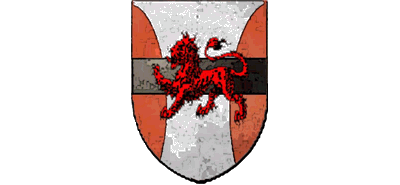
Liquid fire cut the charcoal, viscous smoke, providing the only light by which we could watch our homes disintegrate.
The Act of Benevolence
The Drakshal Act of Benevolence toward our citizens, 900 years ago, rings with peace, love and generosity that exemplifies the highest ideals of Arimathica. Kerr’s assault on our city left us with rubble, cinders, and unburied dead. With nowhere else to turn, our survivors made the long march to their Monastery. The Monks graciously tended to our wounded, fed our hungry, and housed our homeless. While this act seems exceptionally kind, the protection of an entire city’s refugees is, by definition, the way of the Drakshal. We commemorate their benevolence, and reinforce our gratitude annually, because that is the way of Arimathica.
This sermon, however, wishes to stress a facet of the Drakshal Way that goes beyond their simple benevolence toward our then fledgling city. The remarkable kindness of the Drakshal cannot be seen in this act. This act, albeit exceptionally kind, might be expected. Drakshal are humans, much as Galencians are humans. As neighbors, we share the much of the same hardships in climate and monstrous enemies. What they did was a neighborly act, one of kindness, to those much like themselves.
What sets the Drakshal apart, as shining examples of the Arimathican way, is that they would have, and still will, demonstrate similar benevolence toward any peoples, no matter how different, that might stumble helpless and homeless, upon their proverbial door step. If a contingent of Elynthi, complete with the fiendish allies, were to arrive at the monastery, bleeding and broken, the monks would feed, cloth, house, and heal them as well. They do not discriminate when it comes to aiding those in need. They assist the desperate, evil and good alike, as long as they are suffering.
This indiscriminate kindness toward any needy soul outshines their simple assistance after the dragon’s assault. They, like Arimathica, will heal any, even if those that they heal would not reciprocate the favor. We must remember this ideal, and hold it in our hearts. While we stare back into the annals of history, and remember a time of plagues, wars, and famine, we must remember that, like the Drakshal, any that are downtrodden deserve our full devotion and time.
Please turn your hymnals to page 54 and join us in the celebration of Arimathica’s warmth.
— Sermon on the 900th Anniversary of Drakshal Benevolence by Archcardinal Rembrant IV of the Arimathican Church, Kingsday, Thirdscore, the Crimson Moon, 443 AC
Founding Date
866 BC
Type
Geopolitical, Kingdom
Capital
Training Level
Semi-trained
Veterancy Level
Recruit
Demonym
Galencian
Leader
Government System
Monarchy, Absolute
Power Structure
Feudal state
Economic System
Market economy
Subsidiary Organizations
Location
Official Languages
Controlled Territories
Neighboring Nations
Notable Members
Magic In Galencia
Much to the grave sadness of the Soulmeliti across Tarien, as they had just recently re-gained their homelands, Galencia sided with Eldoria and other human nations by banning magic and burning magi during the hysteria of early 600’s. Fortunately, no Soulmeliti were declared sorcerers and burned in Galencia, allowing the beleaguered Soulmeliti to take the longer view of situation and maintain mostly positive relations with their historical allies. Khadra, which tolerate but rarely practice magic, took a similar view, shrugging the incident off as “humans being humans”. Of all of the irrational acts they have taken over the millennia, this seemed to them to be the least insane.
Unfortunately, the self-immolation of a young sorceress burned the cathedral of Arimathica to the ground 621 AC triggered deep cultural trauma for Galencians. Tales of Kerr’s attack on the are taught to children on their parents’ knees and the Cathedral was a national symbol of Galencian perseverance in those dark times. After the event, hunts for magi intensified and hundreds were executed. The King even went so far as to recruit a small cadre of Mennethite priests to assist in interrogations.
In the end, after nearly a generation of fires, the Mage Wars burned to a smolder and people returned to their lives. The memories of the Cathedral’s destruction, however, remained fresh. Galencia passed – and still enforces – some of the most draconian anti-mage laws on Tarien outside of Mennith, Drakkar, and Warwick. Not only is the practice of magic strictly prohibited, aiding a mage, defined to include possessing knowledge of one without informing the authorities, is punishable by death. Burnings are rare as the spark of magic has been stomped out over the past century, but they still occur. The public spectacles are a stark reminder of what hatred and fear can do.
Khadric Darkness
Two and half millennia ago, in an age when elders among the Khadra still recalled the discovery of magic and the Great Flight, before even the first tunnels of New Kharolin were dug, a pair of explorers found the entrance to a cave, situated high on a cliffside in the Southern Rheuthengage mountains. No humans claimed these lands at the time; they would not settle around the shores of Lake Galen for seen hundred years. So when the explorers, delved into the mines, discovering bright, silvery veins of mithril, all of New Kharolin rejoiced.
For nearly a century the mine produced mithril in huge quantities, allowing the Khadra to forge magnificent tools and enjoy lucrative trade with the Soulmeliti. Then, in the depths, miners found a darker substance, stronger and lighter: adamantine. Craftsmen and weapons makers rejoiced and mining efforts tripled. Though difficult to extract, several tons were pulled from the mine in a short, furious decade.
And then it collapsed. First a vein, killing over 500 miners. Survivors claimed that dark figures pulled first the tunnel supports and then the very rocks themselves down around them, the debris passing though their shadowy bodies. The murders began next – Kharda gutted in their sleep, found eyes wide with horror in pools of their own blood. By 1517 BC, reinforcements from New Kharolin learned the stark truth of the mine and ordered it sealed, trapping hundreds below. What truth they learned was never spoken aloud, never written down, and lost to history. Even the location of the mine was struck from Khadric annals.
There are stories of adventurers seeking the ruins are traded in tavern rooms across Galencia. The lure of mystery and the wealth of adamantine, now strictly hoarded by the Khadra, lighting wonder and greed in the eyes of the brave. And while dozens of parties have ventured into the wild mountains, none, are believed to have found the mine. Or at least, none have found it and returned.
You shun us. You ostracize us. You cry for us to burn. Very well. Burn I shall.


